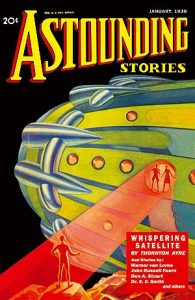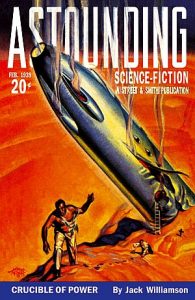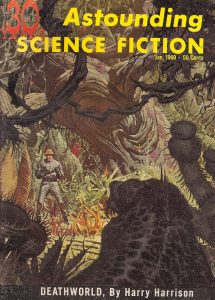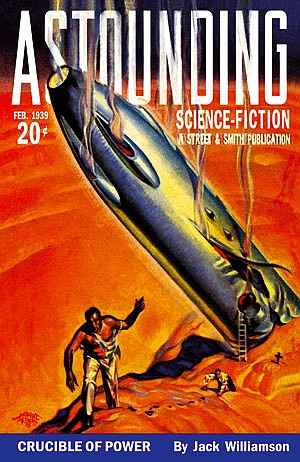 Hired by Street & Smith in 1937, John W. Campbell became the editor of Astounding Stories upon the promotion of F. Orlin Tremaine. Writing under his own name and several pseudonyms, Campbell was one of the leading science-fiction writers of the 1930s. His story “Twilight,” published in the November 1934 Astounding under the Don A. Stuart pen name, is considered a science-fiction classic.
Hired by Street & Smith in 1937, John W. Campbell became the editor of Astounding Stories upon the promotion of F. Orlin Tremaine. Writing under his own name and several pseudonyms, Campbell was one of the leading science-fiction writers of the 1930s. His story “Twilight,” published in the November 1934 Astounding under the Don A. Stuart pen name, is considered a science-fiction classic.
While he worked through a backlog of stories purchased by his predecessor, Campbell began making changes to the magazine, or “mutations,” as he called them. The first major “mutation” came with the March 1938 issue when the magazine became known as Astounding Science-Fiction.
Wanting to create a science-fiction magazine for mature readers, Campbell asked his authors to provide readers with “new worlds that science might offer.” Writers, both new and old, began to respond: Lester Del Rey with “The Faithful” and “Helen O’Loy;” Jack Williamson with “The Legion of Time;” and L. Ron Hubbard with “The Tramp.” Campbell himself joined in with “Who Goes There,” as did Clifford D. Simak, who had left the field, and new writers L. Sprague de Camp and Eric Frank Russell. Seasoned professionals such as Arthur J. Burks, Raymond Z. Gallun, and Manly Wade Wellman also joined in.
 But Campbell had merely been tilling the soil in 1938, preparing it for the blossoming of science fiction’s Golden Age in 1939. The stage was set when the February 1939 Astounding Science-Fiction featured the magazine’s first cover by Hubert Rogers. A free lance illustrator long associated with Adventure, Rogers would eventually paint nearly sixty covers for Campbell’s Astounding.
But Campbell had merely been tilling the soil in 1938, preparing it for the blossoming of science fiction’s Golden Age in 1939. The stage was set when the February 1939 Astounding Science-Fiction featured the magazine’s first cover by Hubert Rogers. A free lance illustrator long associated with Adventure, Rogers would eventually paint nearly sixty covers for Campbell’s Astounding.
Although the outpouring of exceptional fiction continued in the new year with stories such as Simak’s “Cosmic Engineers” and Williamson’s “One Against the Legion,” it is the July 1939 issue that is cited most often as the start of the Golden Age of Astounding and in turn, of science fiction. Behind a very effective cover by artist Graves Gladney, the reader would find the first prose fiction by A. E. van Vogt as well as Isaac Asimov’s first story for Campbell’s magazine. August’s and September’s issues continued the trend with the first stories of Robert A. Heinlein and Theodore Sturgeon appearing in the magazine. October’s number began the serialization of E. E. Smith’s “Gray Lensman,” along with another tale by Heinlein.
The forties brought with them the flowering of Robert Heinlein with stories such as “The Roads Must Roll,” “Blowups Happen,” “Universe,” and “Methuselah’s Children,” all published under his own name, and “Sixth Column,” “By His Bootstraps,” and “Beyond this Horizon,” published under the his Anson McDonald pseudonym. Isaac Asimov began to be heard with works such as “Nightfall” and the first stories of his robot and “Foundation” series. A. E. van Vogt contributed “Slan” and began the “Weapon Shops” tales. And L. Ron Hubbard’s “Final Blackout,” serialized in 1940, caused a substantial stir.
As the decade wore on, World War II began to effect Astounding as Campbell’s writers were pulled away to help with the war effort. Others however, emerged to take their place. Writing as Lewis Padgett, Henry Kuttner and C. L. Moore contributed such tales as “The Twonky” and “Mimsy Were the Borogoves” while Jack Williamson, writing as Will Stewart, began the “Seetee” series. Lester del Rey’s “Nerves” became one of the most popular stories published in 1942 while Fritz Leiber’s “Gather Darkness” and C. L. Moore’s “Judgment Night” were two of the best to appear in 1943. Hal Clement, Raymond F. Jones, and George O. Smith all began writing for Campbell during this period and Murray Leinster returned to Astounding. The magazine itself also went through a couple of changes during this time, becoming letter-sized at the start of 1942 and a digest at the end of 1943.
Although Astounding Science-Fiction would continue to publish outstanding works of science fiction throughout the war and for many years to come, the magazine’s and science fiction’s golden luster began to diminish as the years wore on. As the fifties began, it became increasingly apparent that Galaxy Science Fiction and The Magazine of Fantasy and Science Fiction had become the leading lights of magazine science fiction. Although John Campbell would win eight Hugo Awards for best editor between 1952 and 1965, his age was past.
 In 1960, Astounding was renamed Astounding/Analog Science Fact & Fiction. The “Astounding” was dropped from the title with the October 1960 number when it became known as Analog Science Fact-Fiction. It has survived into the present time using some sort of variation on that title. John Campbell continued to edit Astounding/Analog until his death in July 1971. He was succeeded as editor, first by Ben Bova, and later by Stanley Schmidt and Trevor Quachri. The magazine was sold to Davis Publications in 1980 and Dell Magazines in 1992, the company that publishes it today.
In 1960, Astounding was renamed Astounding/Analog Science Fact & Fiction. The “Astounding” was dropped from the title with the October 1960 number when it became known as Analog Science Fact-Fiction. It has survived into the present time using some sort of variation on that title. John Campbell continued to edit Astounding/Analog until his death in July 1971. He was succeeded as editor, first by Ben Bova, and later by Stanley Schmidt and Trevor Quachri. The magazine was sold to Davis Publications in 1980 and Dell Magazines in 1992, the company that publishes it today.
To learn more about the image used in this post, click on the illustrations. Click here for references consulted for this article.






